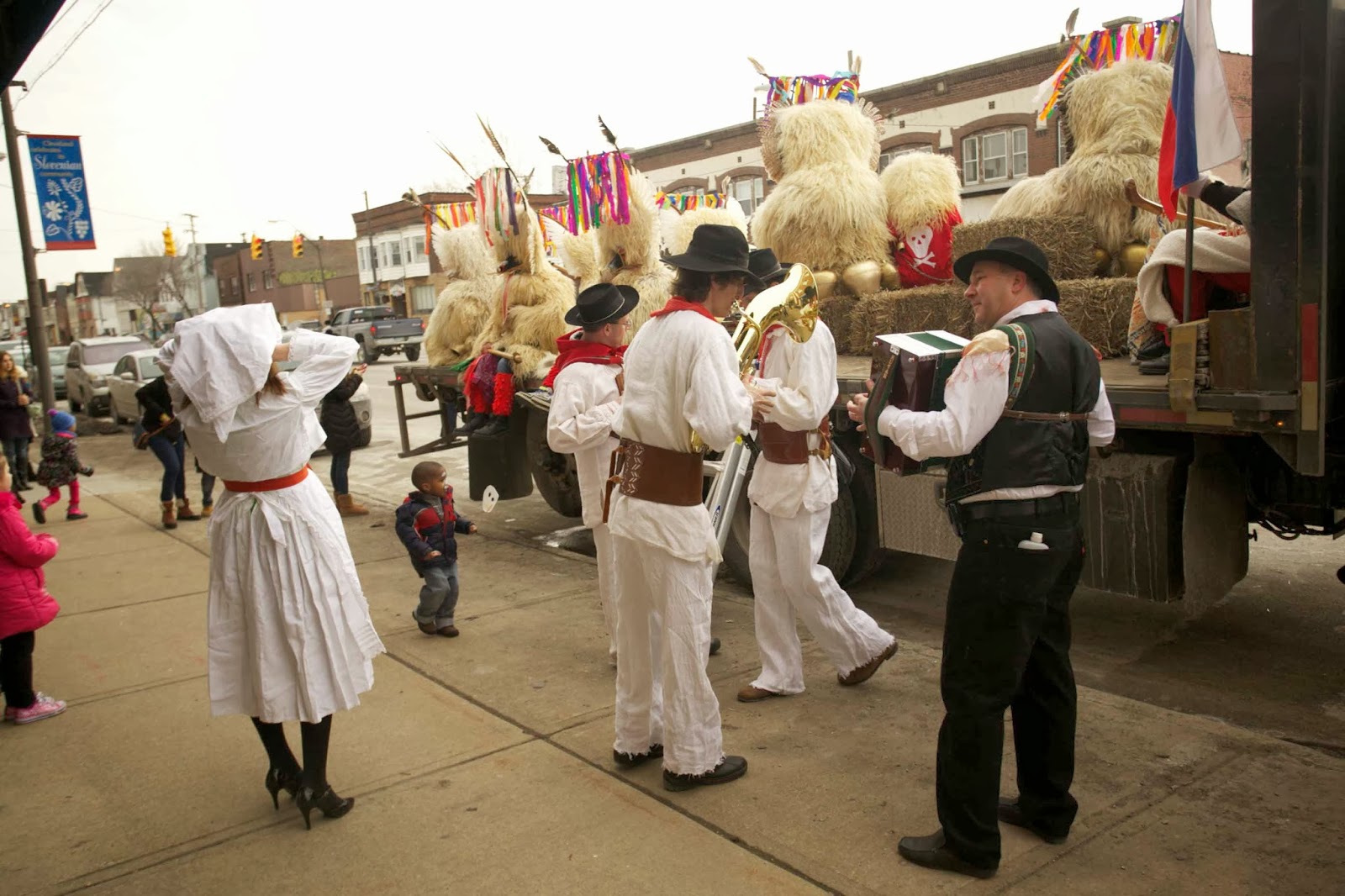Click any pics for a closer look.
When we arrived, we were a bit disappointed.
The area is very rundown.
The entire area was desolate with very few people on the streets.
We thought that we might have wasted our time driving all this way.
And then we caught sight of this. Yes....BINGO!
Wow!
Korents!!!
The first ones either of us had ever seen. These costumes were custom made in Slovenia. They are made of sheep skin and feathers and horns. They all wear 3 large bells on their backs and they have long red tongues.
Their job is to run around the village and chase away the spirits of winter.
They are accompanied by a band, of course.
What a lively group, we had so much fun.
The kurents were wondering who this strange guy is.
And off they go to the start of the parade.
I will show you much more of the Korentovanje Festival tomorrow. If you would like to read more about it, this is from a site I found:
Kurentovanje stems from a hundred-year-old tradition of celebrating the Carnival in the areas of Dravsko and Ptujsko polje
Kurent (also known as korant) is the
central traditional carnival figure in this part of the world, and the
most popular and widespread traditional carnival figure in the areas of
Ptujsko and Dravsko polje and Haloze. The Ptuj carnival, called
Kurentovanje, which is the largest carnival festival in Slovenia, with a
long tradition, was named after it. The Ptuj event is designed to
preserve the cultural heritage and ethnographic tradition of the Ptuj
region as well as of Slovenia. Kurentovanje, which is one of the most
important traditional events in Slovenia and Central Europe, stems from a
hundred-year-old tradition of celebrating the Carnival in the areas of
Dravsko and Ptujsko polje, and always brings magical joy and good
humour. The present day kurent stems from folk tradition. In the old
days, only unmarried men were allowed to put on the kurent costume,
while today anyone, even a woman, a married man or a child, can wear it.
The main role that kurents have today is the preservation of carnival
cultural heritage and tradition. In the lowland as well as the
mountainous part of Haloze in the Ptuj area, the kurent’s role has
always been to drive away winter by jumping from side to side,
bell-ringing and rituals, which is why they are thought to have
supernatural powers. In the country, the arrival of the kurent has
always announced the beginning of the new life which comes with the
springtime. Therefore, this creature has always been respected.
Variety of costumes
There are two types: the one from the
town of Markovci is covered in feathers; the other comes from the town
of Haloze and wears horns. Each kurent wears a mask or a cap made from
sheep skin, although sometimes rabbit fur is also used.
Its ears are made of bird wings, the nose
is long and trunklike, and its moustache is made of maize, while white
beans threaded on a string serve as teeth. A long red tongue of red
cloth or leather is made to look as frightening as possible.
The other type looks the same, except for
the cow horns and ears which are made of animal skin. Kurents usually
wear a light coloured sheepskin, although they can sometimes be black.
They continually whirl and jump around to sound the five cow bells that
they wear fastened around their waists by metal chains. They also wear
green or red leg warmers and heavy work boots. In their hands they hold a
ježevka, a thin wooden bat with real hedgehog spikes at the top end
which used to serve as a weapon. Ježevka is decorated with colourful
handkerchiefs which a kurent has been given by girls.
The kurent with the most handkerchiefs is
believed to be the most popular among girls. The greatest disgrace a
korant could face was to have his mask taken off. At least one devil,
who wears a red costume made from cloth, always accompanies a larger
group of kurents. Devils can move more freely than kurents, so they help
them in many ways. They also always frighten children.
It is possible to say that a kurent also
known as korant is a mascot, a symbol and an ambassador of Ptuj, the
Ptuj region and the whole of Slovenia. Kurentovanje in Ptuj is not just
another festival, but an experience which one remembers forever.















Comments
You sure need those guys to get rid of Your cold winter :-)
Looking forward to more!
Have a great day!
Christer.
Blimey, they are wearing a whole menagerie! Birds wings and hedgehog spikes...
Slovenia is a beautiful country at any time of the year and well worth a visit. The food is excellent.